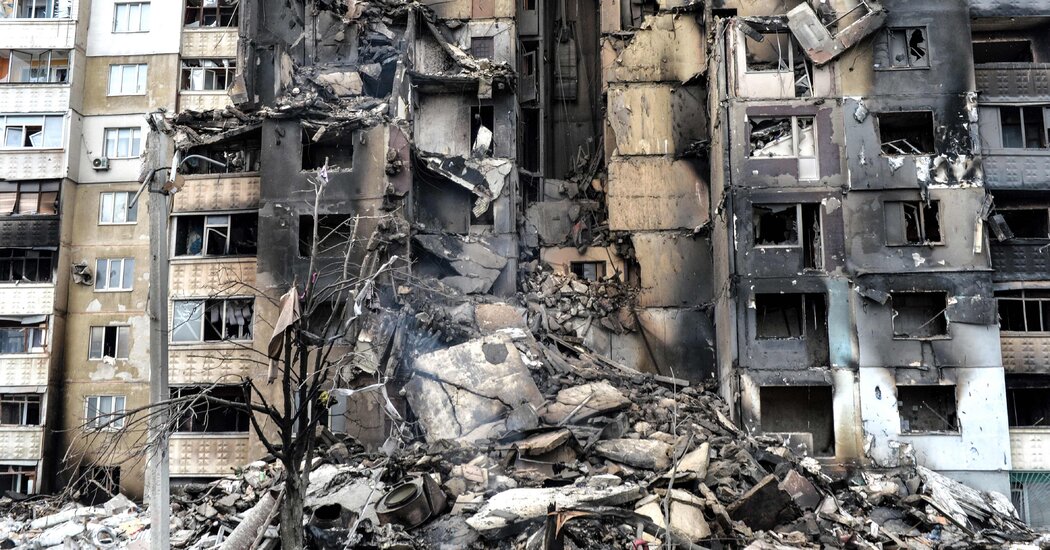
Russia’s international disinformation campaign seemed to flounder in the early days of the invasion, as narratives about Ukrainian bravery dominated the internet. But in Russia, the country’s propaganda machine was busy churning out a deluge of misinformation aimed at its own citizens.
The narrative disseminated online through state-run and unofficial channels has helped create an alternate reality where the invasion is justified and Ukrainians are to blame for violence. To control the narrative at home, Russia also shut down access to several websites and threatened the news media with long prison sentences for criticizing the war. There’s some evidence that the effort has mollified at least some Russians.
Here is what the war looks like to Russians, based on a review of state news articles, channels on the popular chat app Telegram, and input from several disinformation watchdogs who are monitoring Russia’s propaganda machine.
After Russian shellings killed Ukrainian civilians, Russia blamed ‘neo-Nazis.’
Some of the most disturbing images from the war have come from Mariupol, a port city in the southeastern coast. Shelling battered the region, killing several civilians who were trying to flee the area, during what was supposed to be a cease-fire.
But Russians got a different explanation online: Ukrainians had fired on Russian forces during the cease-fire, and neo-Nazis were “hiding behind civilians as a human shield,” according to the Russian state news website Tass.
Neo-Nazis have been a recurring character in Russian propaganda campaigns for years, used to falsely justify military action against Ukraine in what Russian officials have called “denazification.” Those claims have only continued during the conflict. To explain away attacks on other Ukrainian apartment buildings, the same article by Tass claimed that neo-Nazis had placed “heavy weapons in apartment buildings, while some residents are forcibly kept in their homes,” providing no evidence.
Russian social media accounts have used a mix of fake and unconfirmed photos showing Ukrainian soldiers holding Nazi flags or photos of Hitler. An analysis by the Center for Information Resilience, a nonprofit focused on identifying disinformation, showed that the number of tweets connecting Ukrainians to Nazis soared after the invasion began.
“Propaganda works when it coincides with your existing assumptions,” said Pierre Vaux, a senior investigator at the Center for Information Resilience. “The stuff that chimes into the Nazi stuff is really effective.”
After a nuclear facility caught fire, Russians claimed they were protecting it.
After Russia attacked an area near the nuclear complex in Zaporizhzhia, leading to a fire, President Volodymyr Zelensky of Ukraine called it “nuclear terrorism.”
But according to a Kremlin statement reported in Tass, the military seized the facility to prevent Ukrainians and neo-Nazis from “organizing provocations fraught with catastrophic consequences.” Even though Ukrainians heavily fortified the region against an attack, Russian officials claimed they already had control of the compound before Ukrainians opened fire. They added that Ukrainians set fire to an adjacent building before fleeing, providing no evidence. Western experts said controlling the Zaporizhzhia complex would allow Russia to trigger blackouts or shut down the entire power grid.
The image of Russia as a world protector surfaced again after the country’s officials claimed they discovered evidence that Ukraine was working on a nuclear bomb. According to Russian officials, plans for the bomb were uncovered at the abandoned Chernobyl nuclear power plant.
“It doesn’t even make sense, because if you’re going to develop a nuclear weapon, you don’t do your secret development in a nuclear power plant,” Mr. Vaux said. “But that kind of thing is just being beamed out on Russian state TV.”
After Russia shelled a residential neighborhood, Russians claimed Ukrainians did it.
An attack on Kharkiv, a northeast Ukraine city bordering Russia, provided additional evidence that Russia had indiscriminately bombed residential neighborhoods and killed civilians, according to the Atlantic Council, an American research group. The International Criminal Court opened an investigation into war crimes after the assault.
In one attack that included heavy shelling, 34 civilians were killed and 285 were injured, according to the Ukrainian State Emergency Service.
But Russians listening to state media or browsing channels on Telegram heard another story: The missiles, those sources claimed, came from Ukrainian territory.
Russia-Ukraine War: Key Things to Know
On a Telegram channel for the Russian news site Readovka, one post described how “Ukrainian missiles” had “arrived from the northwest” — an area controlled by the Ukrainian military.
Russia’s defense department said that it never attacked cities, instead targeting “military infrastructure” with “high-precision weapons,” according to an article in the state-owned news agency RIA Novosti.
After attacks bloodied civilians, Russians called injured Ukrainians crisis actors.
A woman who survived a blast at her apartment building became the focus of disinformation efforts after her bloodied and bandaged photograph spread widely through newspapers and Western media.
The woman was a resident of an apartment complex in Chuhuiv, near Kharkiv. The photojournalist Alex Lourie captured her portrait after the attack, and the image was soon featured on the front pages of newspapers around the world.
But Russian social media channels falsely described her as a member of Ukraine’s psychological operations unit, according to an analysis by the Ukrainian fact-checking website StopFake.
A post by “War on Fakes,” a pro-Russian website and Telegram channel that appeared at the start of the invasion, suggested that the blood could be grape juice and that the woman could be “part of the territorial defense.” As evidence, the post included a shot of another woman bearing some resemblance. That image came from a New York Times photograph, which was taken in Kyiv — a seven-hour drive west of Chuhuiv.




